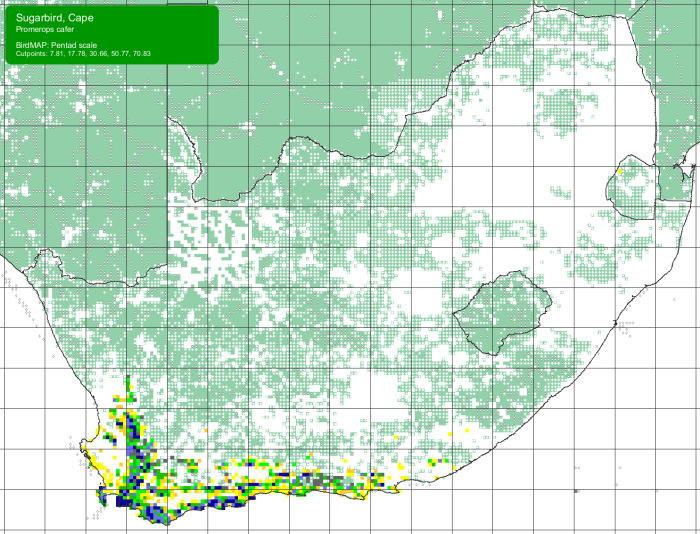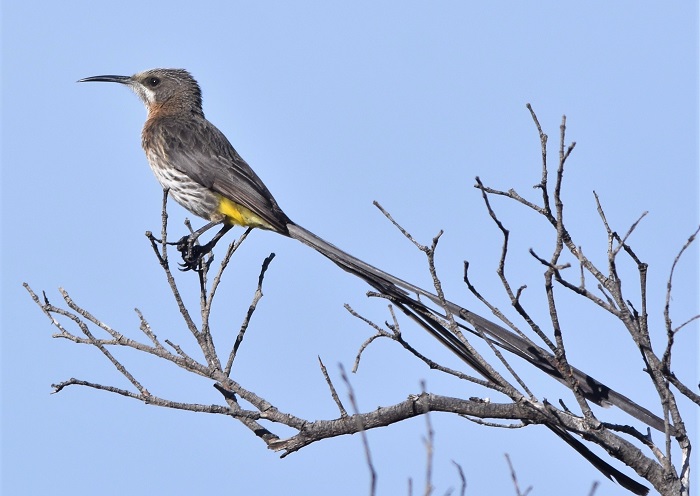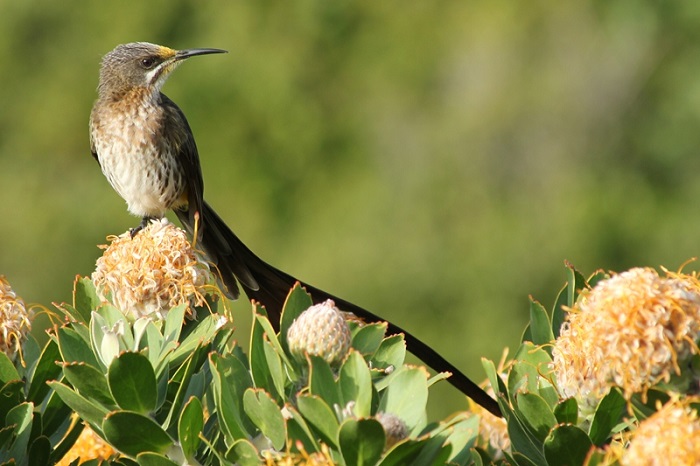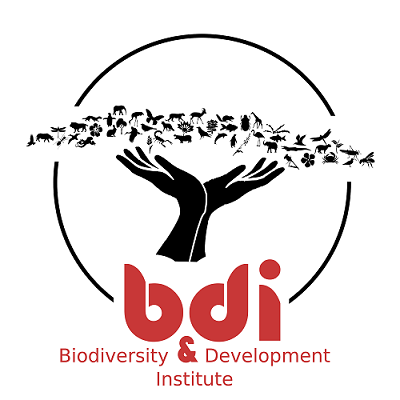Cover image by Marna Buys – Kirstenbosch, Western Cape – BirdPix No. 61050 Cape Sugarbird
Identification
The Cape Sugarbird is a very distinctive species, resembling an overgrown and long-tailed sunbird.
The sexes are alike in plumage colouration but males are larger and have much longer tails. The tail length in adult males varies considerably and can be up to 3 times the length of the body.

Van Stadens Wild Flower Reserve, Eastern Cape
Photo by Philip Nieuwoudt
The upperparts are brown with indistinct darker blotches or streaks, especially on the mantle. There is a prominent malar stripe on the lower face with a white stripe above it. The chin and throat are off-white and the upper breast is brown with feint paler mottling. The lower breast and belly are greyish-white with distinct brownish-black streaking. The vent is bright yellow and conspicuous. In flight they show a greenish-yellow rump. The dark brown tail is long (very long in males), graduated and ribbon-like.

Near Stilbaai, Western Cape
Photo by Johan and Estelle van Rooyen
Juveniles resemble females in having shorter tails but they are duller with browner underparts and lack the yellow vent of the adults.
The Cape Sugarbird is easily recognisable and not easily mistaken for any other species. The closely related Gurney’s Sugarbird (Promerops gurneyi) is smaller with bolder patterning, richer colouration, and a shorter tail. The ranges of the two species overlap very marginally in the Eastern Cape.

Mpofu Dam, Eastern Cape
Photo by Gregg Darling
Status and Distribution
The Cape Sugarbird is a common resident or local-nomad and is endemic to South Africa and the Fynbos Biome. It is restricted to the Western and Eastern Cape provinces. It ranges from near Calvinia and Nieuwoudtville at the north-western edge of its distribution, across to near East London and the Amatola Mountains at the eastern edge of its range.

Details for map interpretation can be found here.
Habitat
The Cape Sugarbird is virtually restricted to the Fynbos Biome and is the quintessential fynbos bird.

Cape Sugarbird (Promerops cafer)
Kleinmond, Western Cape
Photo by Les Underhill
It is sometimes attracted to suburban gardens or patches of alien vegetation, however, its occurrence in other vegetation types is usually due to that habitat being close to Fynbos, or of transient birds moving from one fynbos patch to another. Generally reluctant to leave fynbos, except in response to fire.
Within its chosen habitat, the Cape Sugarbird occurs almost exclusively in places with an abundance of Proteas (Family Proteaceae), often in hilly or mountainous areas.

Rooi-Els, Western Cape
Photo by Gerald Wingate
Behaviour
The Cape Sugarbird is largely sedentary, but becomes nomadic during the non-breeding season, moving locally in response to food availability. The flight is fast and direct with the tail streaming out behind.
During the breeding season the Cape Sugarbird is most often encountered solitarily or in pairs. However, they may be found in groups of up to 12 at a rich food supply during the non-breeding season.

Cederberg, Western Cape
Photo by Tino Herselman
Forages arboreally in shrubs and bushes, probing Protea flowers and those of other plant species for nectar and insects. Most probing is done while perched but may hover on occasion.
Cape Sugarbirds are strongly dependent on protea nectar and may visit up to 300 flowers per day to meet its energy requirements. It is by far the most important pollinator of many Protea species, even more so than sunbirds. Aside from proteas, sugarbirds will consume nectar from many other plant species including exotic and alien plants.

Cape Sugarbird (Promerops cafer) – Betty’s Bay, Western Cape
Photo by Les Underhill
Cape Sugarbirds supplement their diet with a range of insects and other invertebrates. These are captured by probing vegetation or hawking insects in flight. Large insect prey is killed by slapping them against a branch with quick, sideways head movements. Recorded invertebrate prey includes beetles, bees, flies, ants, wasps, aphids, moths, termite alates and spiders.

Cape Sugarbird (Promerops cafer) – Cederberg, Western Cape
Photo by David Kennedy
Highly territorial during the breeding season. At this time males become aggressive towards conspecifics as well as sunbirds, actively chasing them away from food sources. Females often assist in territorial defence. Potential predators like Southern Boubou (Laniarius ferrugineus), Bokmakierie (Telophorus zeylonus) and Southern Fiscal (Lanius collaris) are also chased off aggresively.

Cape Sugarbird (Promerops cafer) – Near Greyton, Western Cape
Photo by Stuart Shearer
The Cape Sugarbird is monogamous and prior to egg laying the male becomes very protective towards the female and seldom strays far from her side.
The nest is built entirely by the female and is normally placed around 1m above the ground in dense foliage where the nest is well hidden. The nest is a shallow, loose bowl made from twigs, plant stems, rootlets and grass. The bowl is lined with brown protea fluff and bound in place with fine plant fibres.
1 or 2 eggs are laid per clutch, mainly between March and August (peak March-June). This winter breeding peak is closely linked to the main flowering time of proteas. The eggs are Cream to pale buff or pinkish white, marked with grey, brown, purple-black or glossy black blotches, streaks or spots.

Kogelberg Nature Reserve, Western Cape
Photo by John Todd
Incubation starts after the second egg has been laid and all incubation is done by the female. The incubation period lasts for around 17 days. During this time the male remains nearby to protect the nest, either by noisily mobbing potential predators or by performing a distraction display to lure threats away from the nest site.
The nestlings are fed and cared for by both parents and are provided with food for around 15 days after fledging. The female chases fully fledged offspring from the territory after 21 days or so.
Cape Sugarbirds are multi-brooded meaning they will attempt to breed more than once in a single breeding season. In fact the female may start a new clutch while still with dependent offspring.

Cedarberg, Western Cape
Photo by John Todd
Further Resources
Species text adapted from the first Southern African Bird Atlas Project (SABAP1), 1997.
The use of photographs by David Kennedy, Gerald Wingate, Gregg Darling, Itxaso Quintana, Johan and Estelle van Rooyen, John Todd, Les Underhill, Marna Buys, Philip Nieuwoudt, Stuart Shearer and Tino Herselman is acknowledged.
Virtual Museum (BirdPix > Search VM > By Scientific or Common Name).
Other common names: Kaapse suikervoël (Afrikaans); Promérops du Cap (French); Kaapse Suikervogel (Dutch), Kap-Honigfresser (German), Papa-açúcar do Cabo (Portuguese)
Recommended citation format: Tippett RM 2023. Cape Sugarbird Promerops cafer. Biodiversity and Development Institute. Available online at http://thebdi.org/2023/08/26/cape-sugarbird-promerops-cafer/

Wolvengat, Western Cape
Photo by Itxaso Quintana

